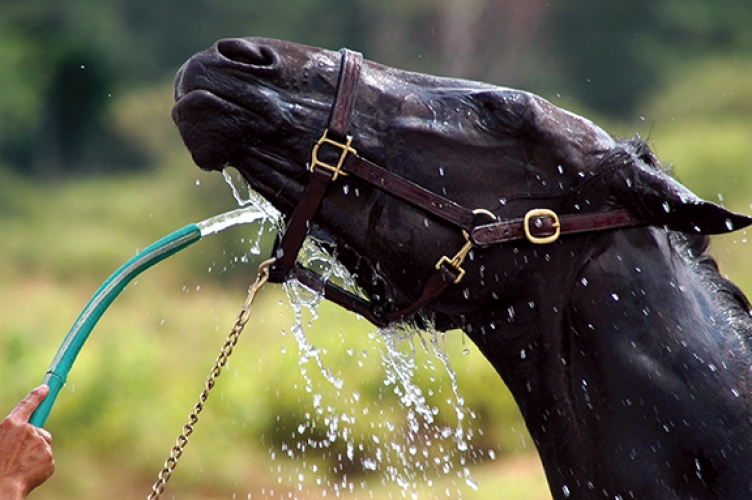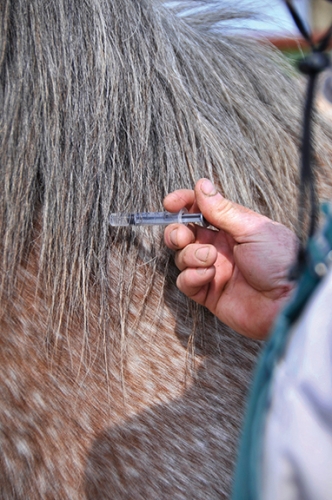
Hives
by Nancy S. Loving, DVM
 There are times when a horse suddenly develops hives for no specific reason. Such a hypersensitivity response to a non-infectious cause is referred to as an allergy, which can range from a serious, life‑threatening systemic reaction (anaphylaxis), to a mild, but disagreeable, skin reaction, such as hives or itching.
There are times when a horse suddenly develops hives for no specific reason. Such a hypersensitivity response to a non-infectious cause is referred to as an allergy, which can range from a serious, life‑threatening systemic reaction (anaphylaxis), to a mild, but disagreeable, skin reaction, such as hives or itching.
Also referred to as urticaria, hives tend to develop about the neck and shoulders, along the thorax, and buttocks. Horse owners often refer to these bumps as feed bumps, protein bumps, or heat bumps since these terms describe some causes of hives. Usually, an allergic reaction remains localized to the skin, but if symptoms persist or are not arrested early on, there may be a systemic response.
 What is an Allergy?
What is an Allergy?
Constant surveillance by a horse’s immune system helps it recognize foreign proteins (antigens) as a threat. In response, the immune system manufactures antibody proteins directed towards specific antigenic targets. An allergic reaction usually isn’t present with first exposure to an allergenic protein. Clinical signs start to appear once the skin becomes sensitized and re-exposed to an offending allergen. Because hypersensitivity reactions take weeks to months or even years to develop, a sudden onset of hives is not necessarily a result of a recent change; this makes it difficult to pin down the actual source of the problem.
Causes of hives are many: a) medications such as antibiotics, anti-parasitic drugs, or hormones; b) vaccines; c) foods like plants, hay, and supplements; d) hypersensitivities like an adverse food reaction, contact allergy, or genetically-linked atopy; e) bacterial, fungal, or parasitic infections; f) stinging insects; g) pollen. Non-allergic factors such as pressure, sunlight, heat, cold, exercise, psychological stress, genetic abnormalities, and adverse reactions to drugs or chemicals may also cause urticaria.
What are Hives?
Hives is a symptom rather than a specific disease. Inflammation induced by allergens dilates small veins to increase capillary permeability in the skin. “Fluid” leaks into surrounding tissues to form wheals or plaques of edema. These first appear as small, firm lumps that may coalesce into a large plaque or line of bumps. With non-complicated hives, overlying skin appears normal with no hair loss and usually no itching. Hives are easily compressed, leaving behind a fingertip imprint of pitting edema, whereas other nodular lesions have cellular infiltration, such as scar tissue or a tumor, and are firm and non-compressible.
A typical hive bump takes 15-30 minutes to reach maximum size. Once the trigger event is gone, the hive usually only lasts for an hour or so. In certain situations, the hive process may persist, with new lesions developing. An allergic response of hives is not usually associated with itching or pain, but in some cases, itching is observed.
One other type of allergic manifestation is a disease called atopy, which tends to be a multi-factorial problem that includes a genetic predisposition – Arabians or Thoroughbreds are reported at higher risk. Typically, the problem shows up by age 4, or if a mature horse is moved to a sensitizing environment. Atopy describes a skin or respiratory allergic response to sensitizing antibodies in the environment, such as seasonal allergens like pollens, molds, grasses, weeds, trees, other insects, dust mites, or blanket or saddle pad materials.
What to Do for Acute Hives
A horse that experiences an acute allergic response should receive veterinary care as soon as possible. While awaiting medical help, keep in mind that many horses with hives look bad but the horse doesn’t know there is a problem. For those that itch, cool water soaks are helpful. It is best not to medicate with drugs or apply topical medications so your veterinarian can see your horse in an unmodified state.
Hives rarely affect the general health of the horse and usually disappear within 1 - 2 days with no treatment necessary. In more severe cases, treatment may be indicated with epinephrine and corticosteroids. Although antihistamines don’t seem to work very well for acute hives, an antihistamine like hydroxyzine may limit the allergic response.
Before implementing treatment during an attack, your vet will attempt to differentiate an allergic response from infections such as skin parasites, bacteria, or fungal (ringworm) infection since even a few days of corticosteroids can turn a mild infection into a severe case that is difficult to resolve. In most cases of ringworm, the hair falls out within a few days, whereas there is no hair loss with hives.
While hives are present on a horse’s skin, it is common sense to refrain from riding him in active exercise. Sweat amplifies the physical discomfort a horse feels around the bumps, and saddle and tack further irritate inflamed tissue.
Identifying the Source
For a single occurrence of hives, you may never discover the incriminating source. However, if hives recurs more than once, tracking the allergen could be helpful. Consider changes in diet, environment, medications, vaccinations, or stress factors within recent months and provide your veterinarian with a list of suspicious items. Strategies for managing hives eliminate ingestion, contact, or inhalation of as many things as possible. With a little sleuthing you may be able to identify the cause and successfully eliminate the problem from your horse’s future. Eliminate new medications or food supplements. Keep only hay in the diet, but you may need to change the source hay. Change bedding materials as well since some horses respond with hives to pine shavings.
A food allergy is most easily ruled out by feeding only hay (with no supplements) for at least 1 – 2 months. In some cases, a certain batch of hay is the source of the problem so you may need to substitute with hay grown by a different source or in a different field. Slowly reintroduce previously offered feed, one product at a time.
Intradermal Allergy Testing
One diagnostic technique uses intradermal (skin) allergy testing to try to isolate an allergic source from pollens (plants, bushes, and trees), molds, grasses, weeds, dust mites, insects, and farm plants. Discontinue medications (steroids or antihistamines) at least 10 – 30 days prior to testing. Thousands of potential allergens exist in the environment, but all can’t be tested.
Serum testing is another method to identify a source of allergens but is less accurate than skin testing. In some cases, extensive and severe skin lesions leave limited intact skin for intradermal testing. In other cases, it is not always possible to discontinue a horse’s medication due to the severity of a problem. If an intradermal skin test comes back negative but clinical signs are consistent with hypersensitivity allergies and other underlying problems have been ruled out, then serum testing may be indicated.
Immunotherapy
Once a particular antigen is identified, immunotherapy (referred to as hypo-sensitization) injections may target that allergen. Injection of small, dilute amounts of allergy vaccine train a horse’s immune system to become tolerant to the allergen over time, resulting in mild to no reaction during re-exposure. Desensitization is a slow process and should be continued for at least one year.
Once a maintenance dose is reached, each injection is given at a 10-20-day interval, depending on a horse’s clinical response. Treatment requires a commitment of time and money, as injections may need to be continued for the life of the horse.
Progressive Allergic Reactions
For most horses that develop a single case of hives, recovery is usually uneventful and rapid, causing little cause for concern. A normal‑functioning immune system keeps your horse disease free, healthy, and vital. This protective system works in harmony with other biochemical responses in the body. It is when it over-reacts that it puts a horse at risk.
Hives can turn into something much more serious, called angioedema. In a classical hive, fluid leaks out of superficial blood vessels in the skin; the amount of fluid that leaks out is limited in its amount because of tissue resistance. With angioedema, the fluid leaks out of deeper vessels where tissue pressures are less, so more fluid can escape, potentially pressing on surrounding tissues. If this develops around a horse’s larynx, the airway will narrow and could close entirely, making this a life-threatening situation. Angioedema most commonly involves the muzzle, eyelids, belly, and legs.
With any allergic condition, there is always concern that the next attack may turn into a severe anaphylactic one. Anaphylaxis is rare in the horse, but it can occur, with the horse exhibiting immediate restlessness and sweating.
When purchasing a horse, question the seller about any known allergic responses. Inform your veterinarian, trainer, and barn manager about the dangers of certain drugs that affect your horse’s health. Just as people who are allergic to bee stings or penicillin may wear a necklace or wristband describing this condition, you can prevent an anaphylactic reaction to known substances by advertising this fact about your horse. A red alert warning sign describing known allergic reactions should be placed outside the horse’s stall and all caretakers alerted to the possibility of an allergic reaction.



